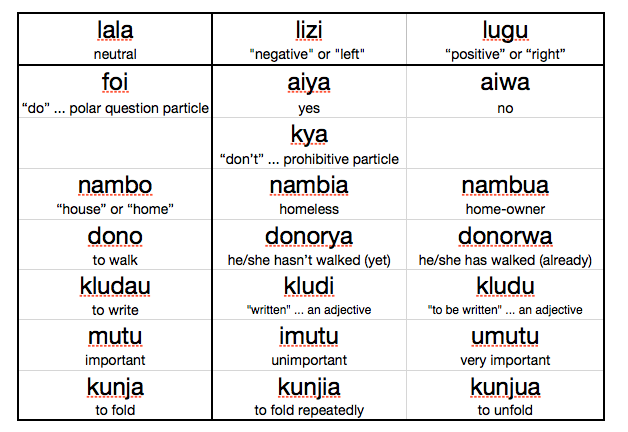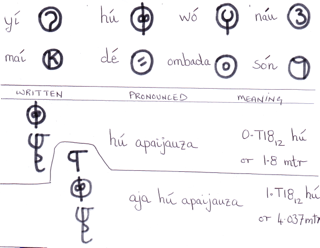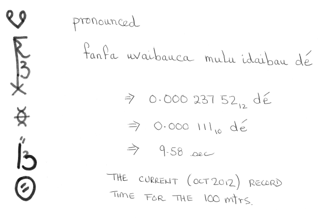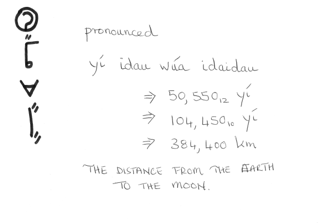Béu : Chapter 9: Difference between revisions
| Line 41: | Line 41: | ||
|align=center| to be scared, fear | |align=center| to be scared, fear | ||
|- | |- | ||
|align=center| '''k k''' | |align=center| '''k k''' | ||
|align=center| she is hungry | |||
|align=center| '''k k''' | |||
|align=center| to be hungry, hunger | |||
|- | |- | ||
|align=center| | |align=center| '''k k''' | ||
|align=center| '''k k''' | |align=center| he is thirsty | ||
|align=center| '''k k''' | |||
|align=center| to be thirsty, thirst | |||
|- | |- | ||
|align=center| '''k k''' | |align=center| '''k k''' | ||
|align=center| she is horny | |||
|align=center| '''k k''' | |||
|align=center| to be horny, horniness | |||
|- | |- | ||
|align=center| '''k k''' | |align=center| '''k k''' | ||
|align=center| he hurts | |||
|align=center| | |||
|align=center| '''k k''' | |align=center| '''k k''' | ||
|align=center| to ache, pain | |||
|- | |- | ||
|align=center| '''k k''' | |align=center| '''k k''' | ||
|align=center| she is ashamed/shy | |||
|align=center| | |||
|align=center| '''k k''' | |align=center| '''k k''' | ||
|align=center| to be ashamed/shame/shyness | |||
|- | |- | ||
|align=center| '''k k''' | |align=center| '''k k''' | ||
|align=center| he is anxious | |||
|align=center| | |||
|align=center| '''k k''' | |align=center| '''k k''' | ||
|align=center| to be anxious, anxiety | |||
|align=center| to be | |||
|} | |} | ||
Revision as of 23:07, 10 December 2013
How concepts relate to parts of speech
béu differs slightly from English, in that the primary form of most words relating to body states are verbs. In English they tend to be adjectives.
For example ;-
| mauzora | he is bored | màus | to be bored, boredom |
| naizora | she is interested (in something) | náis | to be interested in something, interest |
| keuzora | he's not well | kéus | to be ill, illness |
| boizora | she's well | bòis | to be healthy, health |
| ʔoimora | he is happy | ʔoime | to be happy, happyness |
| heunora | she's sad | heuno | to be sad/sadness |
| swuʔora | he is afraid | swuʔa | to be scared, fear |
| k k | she is hungry | k k | to be hungry, hunger |
| k k | he is thirsty | k k | to be thirsty, thirst |
| k k | she is horny | k k | to be horny, horniness |
| k k | he hurts | k k | to ache, pain |
| k k | she is ashamed/shy | k k | to be ashamed/shame/shyness |
| k k | he is anxious | k k | to be anxious, anxiety |
..... Word building
Many béu words can be analysed as being constructed from more basic elements.
We have given the structure of the béu noun phrase already (see ??). If a phrase consisting of the head plus a genitive or the head plus an adjective occur together many times and/or their meaning starts to take on nuances which are more than the sum of the two constituant elements then the two words coalesce . When 2 words coalesce ;-
1) The genitive suffix n is dropped
2) The first syllable of the first word is dropped.
3) The remainder of the first word is affixed to the second word.
Here are some examples ;-
| gxx = | to raise .............................. | gonai = | a machine | gonai gxx.n = | "a machine of levitation" | => | gxxnai = | a lift or an elevator |
| glxx = | to rise | tagu = | a tool | tagu glxx.n = | "a rising tool" | => | glxxgu = | a ladder |
| nandau = | a word | toili = | a book | toili nandau.n = | "a book of words" | => | nandauli = | a dictionary |
| limba = | a tongue or language | myega = | a body of knowledge, | myega limba.n = | "the study of language" | => | limbaga = | linguistics |
| a subject |
Word or -DAU
A word = nandau
| jaudu = | movement ............... | nandau = | a word .................... | nandau jaudu.n = | "a word of movement" | => | jaududau = | a verb |
| cwì = | an object, a thing(physical) | nandau = | a word | nandau cwìn = | "a word of an object" | => | cwidau = | a noun |
| sài = | a colour | nandau = | a word | nandau sàin = | "a word of colour" | => | saidau = | an adjective |
Actually jaududau has been shortened further and is jaudau
Person or -BU
A person = glabu
| ww = | a country ............................................ | glabu = | a person .................... | glabu ww.n = | "a person of country" | => | wwbu = | a compatriot |
| xx = | to compete, to struggle | glabu = | a person | glabu xx.n = | "a person of competition" | => | xxbu = | a capitalist |
| yy = | to share | glabu = | a person | glabu yy.n = | "a person of sharing" | => | yybu = | a socialist |
| zz = | the same ?? | glabu = | a person | glabu zz.n = | "a person of the same" | => | zzbu = | a communist |
Complex -ZA
A complex = kaza
Fellow or -PEU
ampeu = a fellow, a peer, someone of the same social status as you
| vv = | a womb | ampeu = | a fellow, a mate .......... | ampeu vv.n = | "a fellow of womb" | => | vvpeu = | a womb-mate, a twin |
| ww = | a class | ampeu = | a fellow | ampeu ww.n = | "a person of class" | => | wwpeu = | a classmate |
| xx = | year | ampeu = | a fellow, a mate | ampeu xx.n = | "a year fellow" | => | xxpeu = | somebody born in the same year as you |
| yy = | a name | ampeu = | a fellow, a mate | ampeu yy.n = | "a fellow of name" | => | yypeu = | a namesake, somebody with the same name as you |
| zz = | aim, objective, a purpose, a cause | ampeu = | a fellow, a mate | ampeu zz.n = | "a person of the same objective" | => | zzpeu = | a comrade |
Subject or -GA
A field of study = myega
Book or -LI
A book = toili
Tool or -GU
A tool = tagu
Machine or -NO
Belief/theory or -GAI
Wagon or -WEU
A vehicle = wèu
Building or -DO
bundo = building
toilido = townhall ... literally bookhouse
Side or -KA
kà = side
aibaka = a triangle
ugaka = a square
idaka = a pentagon
elaka = a hexagon
ò atas nambo = he/she is above the house ... however if "house" is understood, and mention of it is dropped, we must add ka to atas ... for example ...
ò ataska = he/she is above
daunika = underneath
liʒika = on the left hand side
luguka = on the right hand side
noldo, suldo, westa, istu niaka, muaka faceside backside etc. etc.
Area/Station or -KAU
dakau = area, face
ugakau = a tetrahedron
elakau = a cube
ezakau = an octahedron
ajaukau = a dodecahedron
ajauzakau = an icosahedron
Volume/Room or -KAI
dakai = volume, room
moʃikai = water room = bathrooom
= bedroom
= cookroom
= livingroom
= store room
You can name the regular shapes in 4 dimensions.
idakai = a 5-cell
ezakai = an 8-cell
ajaugakai = a 16-cell
uvaukai = a 24-cell
apaukai = 120-cell
agaivaukai = 600-cell
A place/station or -HEU
A place = hèu
A place/shop or -HA
A place = há
Yes it means about the same as bwò.
Professional or -TAI
a professional (a person who's job requires book-learning) = notai
A container or -COI
A container = mencoi
Tradesman or -DA
The suffix -da indicates a person who has learnt skills through instruction and practice, practice, practice.
hand = anda
metalworker = damaida
Shop or -FU
shop/stall = kanfu
Shopkeeper or -FAU
A Seller/Shopkeeper/Merchant= kanfau
Stuff or -YO
powder = ponyo
Language or -BA
A tongue, a language = limba
Metal or -MAI
metal = damai
copper = ʔolimai
bronze = pwemai
iron/steel = gumai
tin = fujemai
lead = wobumai
aluminium = yekimai
zinc <= needle ??
gold <= sun ??
silver <= moon ??
Water or -ZE
water = moze
moze amazon = water of Apple => Apple Juice = amaze
ʔolaze = orange juice
hawan = bee
hawanze = honey
Air/gas or -ME
Air/gas = came ... jamu = wind
hydrogen = mozeme
helium = ombame
Group or -BO
mebo = group
Member or -KE
noke = member
Disease or ʔI
lisʔi = disease
Fish or -PAI
cuttlefish = byopai
Trees or -NYO
Apple tree = amanyo
Mango tree = byonyo
Fruit/nuts or -ZO
Apple = amazo
Mango = byozo
We do not want a "unit", "boat".
⁕⁕nandauli is a good example of béu word building. toili = book, nandau = word, toili nandaun = book of words. However if two words such as these geudidau means extended word. It is also a good example of an extended word, in itself.
geuda is a verb meanbéuing to extend in one direction (usually not up). geudo is an noun meaning an extension or appendix. geudi is an adjective meaning extended.
nandau geudi = extended word ... now when a noun and a following adjective occur together a lot (and maybe take on a meaning slightly different) the concept they represent is normally upgraded to a word, by deleting all but the last CV (consonant vowel) in the first word, and sticking this CV on to the end of the second word.
Hence we get geudidau. In theory there is no limit to the combinations that can occur. However in practice (outside of technical language) there are slightly under a hundred different CV's, and the number of elements that every CV can combine with, varies from 3 or 4 up to about 40.
In English we have a number of common endings, such as "-ism", "-ology", "ist", etc. etc. In béu the end-stuck CV's can be thought of as equivalent to these English endings : the main difference is that this word building process is much more prevalent in béu.
The CV -dau (from nandau) is found in combination with a number of other elements. For example ;-
Note that in the last example, the meaning of the extended word has shifted a bit with respect to the meaning of the original words.
It is possible to extend further an extended word. For example ;-
kaza is an adjective meaning compicated and also is a noun meaning "a complicated thing" or "a complex".
kaza cwipadaun = a complex of a noun => cwipadauza = a noun phrase
YīnYáng
liʒi and lugu can be considered the béu equivalents of Yin and Yang.
According to the Taoist tradition ...
Yin is characterized as slow, soft, yielding, diffuse, cold, wet, and passive; and is associated with water, earth, the moon, femininity and nighttime.
Yang, by contrast, is fast, hard, solid, focused, hot, dry, and aggressive; and is associated with fire, sky, the sun, masculinity and daytime.
Unfortunately the béu tradition is not so delightfully colourful. It is more workaday.
It is basically the association in morphology of the sound i to the negative, and of u to the positive.
Also there is a weaker association of i to the left and the past, and of u to the right and to the future.
wa or -ua or to a lesser extent u- are associated with positiveness.
Also ya or -ia or to a lesser extent i- are associated with negativity.
kludi and kludu might be expected to be swopped over ...
-i is suffixed to indicate an action already done on an object and hence there IS NOT any action pending. ( IS NOT = negative )
-u is suffixed to indicate an action IS pending. ( IS = positive )
Also i is associated with past time and u is associated with future time (refer to the tense/aspect markers).
In the béu mathematical tradition the primary axis is always horizontal. The origin is called the lalapoint.
Negativity is to the left of this point and positiveness to the right. ( OK not so much difference from the way we do things in the West )
In calculus there is a strong preference to vary other dimensions with respect to time.
Units
We have alread discussed numbers quite extensively.
Now it is time to discuss béu units (jada).
The unit of distance is the yí (3.68 km) ... this is actually the radius of the earth divided by 100012.
The unit of height is the hú (2.13 m) ... this is actually the yí divided by 100012.
The unit of weight is the wó (5.6 kg) ... this is actually (the weight of water in a cube with every side one hú long) divided by 100012.
The unit of area is the náu (7,839 m2) ... this is actually (the area of a square with every side one hú long) multiplied by by 100012.
The unit of temperature is the mái (87 degrees Kelvin). This makes the temperature of the human body equal to 3 1/2 units.
Also 3.0 mái is -12 degrees celsius and 4.0 mái is 75 degrees celsius. As the temperature of the air is nearly always between these two limits, when people discuss the weather, they normally drop the "3".
The unit of time is the dé (24 hours).
The unit of angle is the ombada (360 degrees).
The unit of speed is the són (0.15333 km/hour)
The above units are not normally written out in full. But they have special symbols as given below.
Now we must lay down how the unit word interacts with the number and with the 7 number "placeholders". This must be defined for both speech and notation.
Well first of, if the number is such that it is next to omba (the decimal point), then omba is replaced with the units being used (in both recitation and in notation). For example hú is the unit used to measure height (it equals 2.237 mtr). My height (1.8 mtrs) would be pronounced hú apaijauza. A height of 4.037 mtrs would be pronounced as aja hú apaijauza. (see the chart above to see how this would be written down).
Now if the number doesn't occur next to omba but on one side of a placeholder, then the unit is placed on the opposite side from the placeholder.
If the number occurs on both sides of a placeholder, then the unit is place at the very front.
Notice that in the notation the numbers must be contiguous with the placeholders. If there is a gap, then the sign for "h" must be inserted into the gap. Exactly as we insert zero's. But one different between our system and the béu system, is, in our system, zero's must be inserted to make the number contiguous with the decimal point (assuming we are using non-scientific notation), in the béu system "h"'s must be inserted to make the number contiguous with any placeholders that are used.
The béu system may at first appear more complicated then the systems currently used. However it is all a matter of familiarity. It is just due to exposure to it for most of our lives that, for example, using hours, minutes and seconds seems so easy. With all equal amount of exposure, the béu system would be even easier.
In our SI system, magnitude words are prefixed to the unit of measurement (for example "kilo" in kilometre). béu also has magnitude words (the placeholders) but they are inserted into the number itself (the béu system is better than the SI system because you get a different magnitude word every time your dynamic range passes 1728). Notationwise, it is a bit similar to the way we use comma's to separate a long number string into groups of three digits.
This is rubbish
The plovaza (adjective phrase) is a clause that sets the scene for the main action.
1) "waiting on tables six nights a week", Kirsty had come to know all the regular customers // "their mains flowing", they ran across the field and down to the river.
2) "his leg broken", he slowly crawled up the sand dune and ...
3) "having to pack all the stereos before lunch", he did not stop for a tea-break.
In English grammar this is called a nominative absolute construction. It is a free-standing (absolute) part of a sentence that describes or modifies the main subject and verb. It is usually at the beginning or end of the sentence, although it can also appear in the middle. Its parallel is the ablative absolute in Latin, or the genitive absolute in Greek.
Index
- Introduction to Béu
- Béu : Chapter 1 : The Sounds
- Béu : Chapter 2 : The Noun
- Béu : Chapter 3 : The Verb
- Béu : Chapter 4 : Adjective
- Béu : Chapter 5 : Questions
- Béu : Chapter 6 : Derivations
- Béu : Chapter 7 : Way of Life 1
- Béu : Chapter 8 : Way of life 2
- Béu : Chapter 9 : Word Building
- Béu : Chapter 10 : Gerund Phrase
- Béu : Discarded Stuff
- A statistical explanation for the counter-factual/past-tense conflation in conditional sentences



